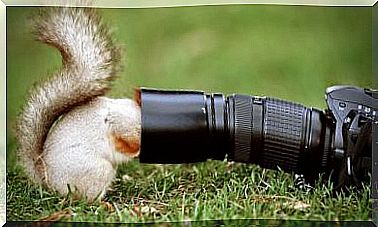Using Tools, A Skill Also Of Animals

Using tools was once something usually linked to human beings, being the only species that used them. However, nowadays, we know of more and more cases of tool use by animals.
More and more, we find that there are fewer differences between humans and the rest of animals. Using tools to make everyday tasks simpler is something that unites us with them. This behavior was first discovered in chimpanzees.
Primates, pioneers in using tools
When young Jane Goodall investigated this species in Gombe National Park (Africa), she found a chimpanzee using branches to “catch” termites from a nest.
This was a milestone, and then other uses of tools by animals and even their manufacture were discovered. For example, this same species removes leaves from branches to catch insects.
Without a doubt, primates are the animals that have been most observed using tools, and especially the great apes. Most are afraid of water and use branches to check the depth of rivers and lakes.
The use of makeshift mills and stone hammers, or even the making of sharp spears for hunting, are other discoveries worthy of a science fiction film. All these techniques are passed on to future generations so that they become authentic cultural phenomena.
Other primates, such as cynomolgus monkeys, use plant fibers, feathers and even human hair to keep their teeth clean, using these filaments as dental floss.
Cetaceans, many unknowns
As for cetaceans, especially if we refer to dolphins, there are many unknowns about their true potential in the use of tools, because they are discarded for lack of hands. However, that didn’t stop them from using some utensils for their benefit.

For example, dolphins in Shark Bay, Australia, use sponges to protect their noses. These cetaceans use the sponge as a bumper, so they don’t get hurt by rocks and corals in their search for food at the bottom of the sea.
In fact, dolphins teach each other this behavior. That ability served the US Army in getting these animals to deactivate the mines, and that gives us an idea of what they could do if they had our limbs.
Other Mammals Using Tools
Elephants are some of the smartest animals, and they are also known for using tools. An example is the use of branches to scare insects or scratch themselves, is that they are able to modify these branches in a specific way for each task.
Elephants were found to be able to make a kind of lid, chewing tree bark, which is used to make groundwater hold longer without evaporation, and also to throw objects to destroy electrified barriers.
A curious example of animal tool use is that of sea otters using rocks to break shellfish. They put them on their bellies to hit them as they float in the sea. The use of tools at a simpler level in bears, badgers and mongooses has also been observed.
Do birds know how to use tools?
Even some birds are able to use tools, among them the most specialized are crows and other similar birds, such as jay and red-billed jay. These, for example, are capable of leaving the nuts on the road for cars to break.

Source: Sigurður Atlason.
This behavior is similar to that of another bird, a scavenger raptor known as a bearded vulture: it drops the bones of the carrion it consumes so that they break and thus consume the marrow.
There are even some authors who consider that making nests is an excellent example of the creation of tools by animals, we can say that almost all birds carry out this type of practice, but we will stick to clearer cases.
Another excellent example is the Camarhynchus pallidus, a bird from the Galapagos Islands that uses small cactus twigs or thorns as an extension of its beak to remove its prey and taste it. Some species of parrots have been observed breaking shells with stones to obtain calcium. Another proof that we are not that different from other animals.









